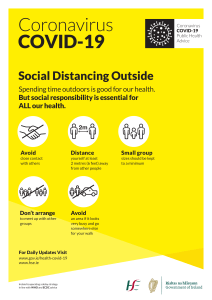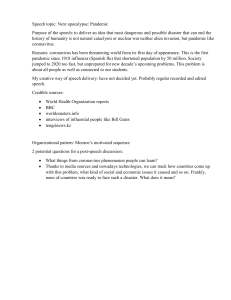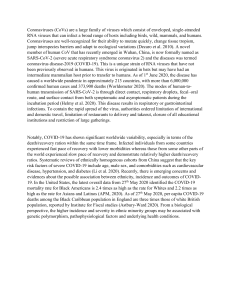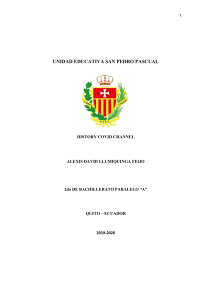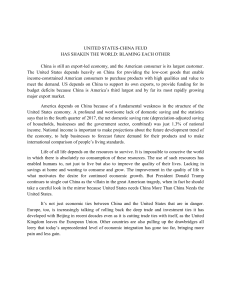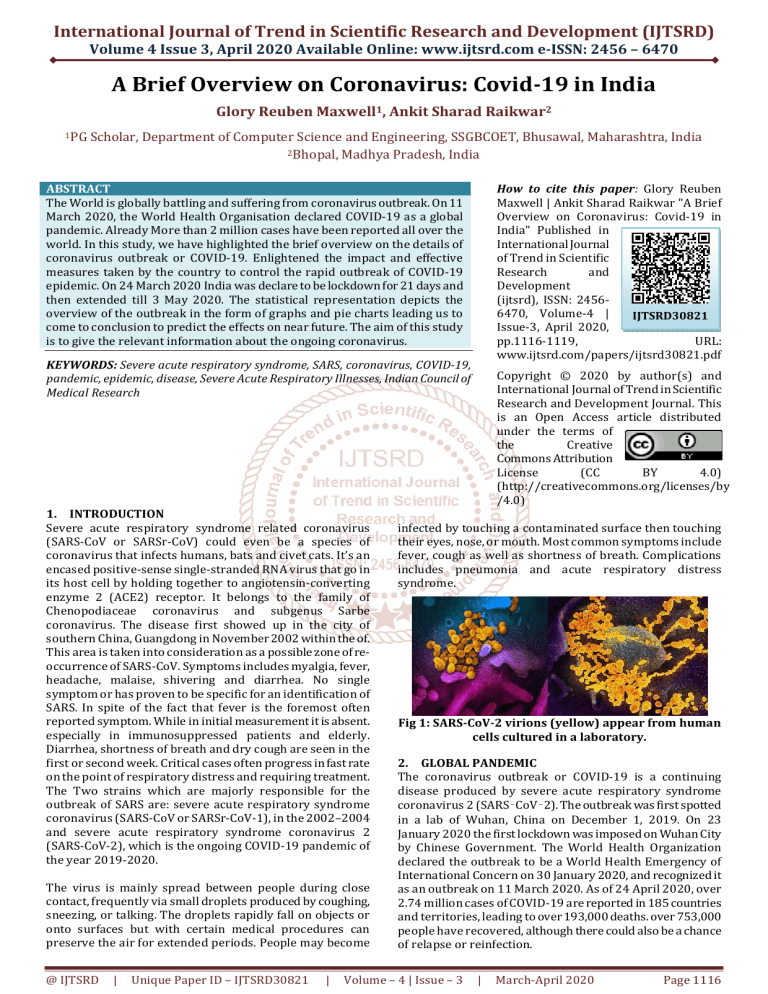
International Journal of Trend in Scientific Research and Development (IJTSRD) Volume 4 Issue 3, April 2020 Available Online: www.ijtsrd.com e-ISSN: 2456 – 6470 A Brief Overview on Coronavirus: Covid-19 in India Glory Reuben Maxwell1, Ankit Sharad Raikwar2 1PG Scholar, Department of Computer Science and Engineering, SSGBCOET, Bhusawal, Maharashtra, India 2Bhopal, Madhya Pradesh, India How to cite this paper: Glory Reuben Maxwell | Ankit Sharad Raikwar "A Brief Overview on Coronavirus: Covid-19 in India" Published in International Journal of Trend in Scientific Research and Development (ijtsrd), ISSN: 24566470, Volume-4 | IJTSRD30821 Issue-3, April 2020, pp.1116-1119, URL: www.ijtsrd.com/papers/ijtsrd30821.pdf ABSTRACT The World is globally battling and suffering from coronavirus outbreak. On 11 March 2020, the World Health Organisation declared COVID-19 as a global pandemic. Already More than 2 million cases have been reported all over the world. In this study, we have highlighted the brief overview on the details of coronavirus outbreak or COVID-19. Enlightened the impact and effective measures taken by the country to control the rapid outbreak of COVID-19 epidemic. On 24 March 2020 India was declare to be lockdown for 21 days and then extended till 3 May 2020. The statistical representation depicts the overview of the outbreak in the form of graphs and pie charts leading us to come to conclusion to predict the effects on near future. The aim of this study is to give the relevant information about the ongoing coronavirus. KEYWORDS: Severe acute respiratory syndrome, SARS, coronavirus, COVID-19, pandemic, epidemic, disease, Severe Acute Respiratory Illnesses, Indian Council of Medical Research 1. INTRODUCTION Severe acute respiratory syndrome related coronavirus (SARS-CoV or SARSr-CoV) could even be a species of coronavirus that infects humans, bats and civet cats. It’s an encased positive-sense single-stranded RNA virus that go in its host cell by holding together to angiotensin-converting enzyme 2 (ACE2) receptor. It belongs to the family of Chenopodiaceae coronavirus and subgenus Sarbe coronavirus. The disease first showed up in the city of southern China, Guangdong in November 2002 within the of. This area is taken into consideration as a possible zone of reoccurrence of SARS-CoV. Symptoms includes myalgia, fever, headache, malaise, shivering and diarrhea. No single symptom or has proven to be specific for an identification of SARS. In spite of the fact that fever is the foremost often reported symptom. While in initial measurement it is absent. especially in immunosuppressed patients and elderly. Diarrhea, shortness of breath and dry cough are seen in the first or second week. Critical cases often progress in fast rate on the point of respiratory distress and requiring treatment. The Two strains which are majorly responsible for the outbreak of SARS are: severe acute respiratory syndrome coronavirus (SARS-CoV or SARSr-CoV-1), in the 2002–2004 and severe acute respiratory syndrome coronavirus 2 (SARS-CoV-2), which is the ongoing COVID-19 pandemic of the year 2019-2020. The virus is mainly spread between people during close contact, frequently via small droplets produced by coughing, sneezing, or talking. The droplets rapidly fall on objects or onto surfaces but with certain medical procedures can preserve the air for extended periods. People may become @ IJTSRD | Unique Paper ID – IJTSRD30821 | Copyright © 2020 by author(s) and International Journal of Trend in Scientific Research and Development Journal. This is an Open Access article distributed under the terms of the Creative Commons Attribution License (CC BY 4.0) (http://creativecommons.org/licenses/by /4.0) infected by touching a contaminated surface then touching their eyes, nose, or mouth. Most common symptoms include fever, cough as well as shortness of breath. Complications includes pneumonia and acute respiratory distress syndrome. Fig 1: SARS-CoV-2 virions (yellow) appear from human cells cultured in a laboratory. 2. GLOBAL PANDEMIC The coronavirus outbreak or COVID-19 is a continuing disease produced by severe acute respiratory syndrome coronavirus 2 (SARS‑CoV‑2). The outbreak was first spotted in a lab of Wuhan, China on December 1, 2019. On 23 January 2020 the first lockdown was imposed on Wuhan City by Chinese Government. The World Health Organization declared the outbreak to be a World Health Emergency of International Concern on 30 January 2020, and recognized it as an outbreak on 11 March 2020. As of 24 April 2020, over 2.74 million cases of COVID-19 are reported in 185 countries and territories, leading to over 193,000 deaths. over 753,000 people have recovered, although there could also be a chance of relapse or reinfection. Volume – 4 | Issue – 3 | March-April 2020 Page 1116 International Journal of Trend in Scientific Research and Development (IJTSRD) @ www.ijtsrd.com eISSN: 2456-6470 There are currently 2,923,656 cases and 203,317 deaths whereas 837,609 patients recovered from the coronavirus outbreak COVID-19. To break the chain of coronavirus many countries have already imposed nationwide lockdown. Figure 2 depicts the Total number cases of coronavirus outbreak in various countries all over the global Fig 2: Graphical distribution of Total cases Globally. 3. COVID-19 IN INDIA On 30 January 2020, India reported its first case of COVID19, originating from China transmitting in Kerala, which rose to a few cases by 3 February; students who had returned from Wuhan, China were tested positive. On 4 March 2020, 22 new cases were found, in which 14 infected members belonged to an Italian tourist group. The transmission rate grew rapidly during the month of March, after various cases were reported all over the country. Total of 23452 cases, 4814 recoveries and 723 deaths were confirmed by the Ministry of Health and Family Welfare as of April 24. Due to COVID-19 outbreak the Epidemic Diseases Act, 1897 was invoked in several states and union territories. Most business establishments and academic institutions were shut down. All tourist visas were suspended by Indian Government, because most confirmed cases were linked to other countries. 3.1. Nationwide Lockdown and Measures The Prime Minister of India Mr. Narendra Modi announced nationwide lockdown on 24 March 2020 starting from midnight for 21 days. This nationwide lockdown for 21 days, affected the entire 1.3 billion population of India. The growth rate of doubling of cases reduced to six days from the last data of three days by 6 April 2020. Announcements On 14 April, 2020 was made by the prime minister to the extent the ongoing nationwide lockdown up to May 3, 2020. PM Modi requested the citizens to follow seven steps to help in the fight against COVID-19, " Take care of elderly people , follow the guidelines set by Ministry of AYUSH to enhance immunity , Download the Aarogya Setu app to trace and track your health, Use homemade masks, Help the poor and needy and Protect jobs." The Prime Minister also announced Rs.15,000 crore assistance to the healthcare sector. Development of testing facilities, ICUs, Ventilators and PPEs for training medical workers will be made by this money. 3.2. Impacts Economy The impact of the pandemic has been hugely disruptive. Credit rating agencies and International Bank for @ IJTSRD | Unique Paper ID – IJTSRD30821 | Reconstruction and development have denigrated India's growth rate for year 2021. This is India’s lowest growth rate figures in last three decades. However, International money projection for India for the year 2021-22 of 1.9% GDP growth is that the foremost effective among G-20 nations. The unemployment rate rose from 6.7% on 15 March to 26% on 19 April within a month. During the pan India, approximately 14 crore people lost employment. As compared to last year there is an income drop outlined by 45% of households. During the primary lockdown, the RBI announced reasonably measures which could make available 374,000 crore to the country's financial set-up. IBRD sanctioned 1 billion dollars in order to support India. On 3 April 2020, around 28,378 crore rupees was released by central government to the states to tackle the pandemic. The Prime Minister, the President, and MPs announced on 6 April 2020 the cut of 30% for one year from their respective salaries. On April 10, 2020 the Asian Development Bank assured India of Rs.15,800 crore abetment to fight against covid-19 outbreak. After the announcement of second lockdown, the RBI Governor announced more measures Rs. 50,000 crore special finance to NABARD, SIDBI, and NHB to overcome the economic impact of the pandemic covid-19. Transportation Flights - The govt. of India announced on 19 March that no international flights will be permitted to land from 22 March 2020. The union government on 23 March announced that all the domestic flights will be shut down from 25 March. Railways and Roadways - On 21 March, Indian Railways announced the termination of 3700 trains in the country. The union government on 22 March announced the cancelation of all train services within the country which includes baring goods trains, 12500 trains, and every nonessential passenger trains. All transportation modes including interstate transport buses, cabs were also banned. The Indian Railways extended the termination of all its passenger trains and also all the ticket bookings till the next announcement. Education On 16 March, all faculties and colleges in the country was declared as state lockdown by union government. On 18 March, CBSE released a revised guideline for examination centers. This includes maintaining a distance of a minimum of 1 meter between the scholars taking the exam with a category not having quite 24 students. he rooms in the examination centers are small in size, then split the students and allocate them in different numerous classrooms. CBSE announced on 19 March that all examinations to be postponed till 31 March 2020.The SSC exams in Madras and Puducherry were postponed to fifteen April. Sports The Board of Control for Cricket in India suspended the 2020 Indian Premier League tournament indefinitely due to the pandemic. BCCI also cancelled the ODI matches between India and Republic of land which was supposed to held on 15 March and 18 March 2020. The 2020 ISSF tourney, which was supposed to be begin from 15 March 2020 in capital of India, was postponed. From 24 March 2020 to 29 March 2020 the Indian Open badminton tournament was supposed to be held in New Delhi which was suspended. Volume – 4 | Issue – 3 | March-April 2020 Page 1117 International Journal of Trend in Scientific Research and Development (IJTSRD) @ www.ijtsrd.com eISSN: 2456-6470 Unemployment The coronavirus lockdown has left tens of variant migrant workers unemployed leading them to take path back to their native. Work from home was declared by most of the IT sectors. Entertainment The International Indian Film Academy Awards, planned to wish place on March 27, was canceled. Cinema halls were declared to be closed by most state governments. Film bodies decided to forestall the assembly of films, TV shows and web series till 31 March. The Indian Broadcasting Foundation declared that four among the major broadcasting networks in the country have decided to relinquish all fees for 2 months. IBF could even be a company promoting the Indian television industry. in an exceedingly statement, the muse said that Sony Pal, go by Sony, Star Utsav, pass Star India, Viacom18's Colors Rishtey pass colors and Zee Anmol pass Zee TV are visiting be available for 2 months free to all viewers within the country. This offer is applicable for all DTH and cable networks. Commercial establishments All the Restaurants, hotels and shops was declared to be shut down except the essential goods shops and medical services. All the e-commerce shopping websites such as flipkart, amazon etc. was allowed to only deliver only essential goods. 3.3. Testing The Union Health Ministry's room and philosophy team in Indian capital includes of the Central Surveillance Unit (IDSP), the ministry's Emergency Medical Response Unit, experts from three government hospitals and the National Centre for Disease Control (NCDC). They seem to be a part of policy decisions to see how coronavirus should be tackled within the country. Initially, the labs conducted the tests samples only who had travel history from 12 countries assigned at high-risk, or for who may have been in contact with corona positive patient. The Union Ministry of Health allowed private pathology labs to test for COVID-19 on 17 March 2020. It was officially declared by the ministry that the work of testing has been doubled after granting the permission to the private labs. Once founded, someone can get test done after knowledgeable physician in an exceedingly government facility recommends it. From 21 March 2020, 111 additional labs for testing became functional. National Institute of Virology and ICMR approved validation to Pune-based molecular diagnostic company Mylab Discovery Solutions on 24th March for its Reverse transcription polymerase chain reaction (RT-PCR) tests. The test takes 2.5 hours and also the corporate is looking to cost it at around Rs.1,200, or Rs 80,000 for a 100-test kit. On the other hand, on 14th March ICMR and Drug Controller General of India (DCGI) granted permission to 18 new suppliers of kits which included three firms, counting the total suppliers as 51. During the span of February 15 2020 to April 2 2020, nearly 5911 Severe Acute Respiratory Illnesses patients were tested all over the country, from which 104 resulted positive in 20 states and UTs. Almost 40% of the patients neither have any travel history nor have any history of contact with a corona positive. ICMR suggested to prioritize infection within the 36 districts belonging to 15 states those who had reported positive SARI (Severe Acute Respiratory Illnesses) patients. @ IJTSRD | Unique Paper ID – IJTSRD30821 | Fig 3: According to ICMR, 579,957 samples have been tested as of 25 April and 24,506 individuals have been confirmed positive. 4. Statistics of Pandemic The outbreak of COVID-19 pandemic rapidly increased within few months resulting in over 2.5 million cases all over the world. According to World Health Organization, 213 countries, areas or territories are suffering from corona virus pandemic. More than 187847 confirmed deaths have been reported. However, In India total number of cases are more than 26 thousand and confirmed deaths are more than 800 whereas more than 5800 patients cured from Covid-19. Figure 5 shows the total number of cases in India according to date wise whereas Figure 6 describes the state wise percentage of covid-19 cases. Fig 4: Total Number of cases in India according to Date wise. Fig 5: State wise percentage of cases. 5. Treatment In March, a mixture of anti-Swine flu, anti-malaria, along with anti-HIV drugs evolved in the betterment of three patients in the state of Rajasthan. Cipla corporation, Council of Scientific and Industrial Research and Indian Institute of Chemical Technology has launched a set forth to produce COVID-19 vaccination drugs. In the same month, ICMR Volume – 4 | Issue – 3 | March-April 2020 Page 1118 International Journal of Trend in Scientific Research and Development (IJTSRD) @ www.ijtsrd.com eISSN: 2456-6470 constituted a new Task Force named as National Task Force for COVID-19 to endorse the utilization of hydroxychloroquine for the cure of high-risk patients. Various PSUs, firms and startups such as DRDO and ISRO, have also reassigned their production lines to manufacture general Personal Protective Equipment, full body suits, mobile medical equipment and ventilators in low cost. Serum Institute of India located at Pune is anticipated to use for clinical experiments of particular strains from Drug Controller General of India. According to the company's president, the vaccine for COVID-19 will be ready to be distributed within a year, however, it may not be effective on 20 to 30% people in the country. In April, invitation was sent by ICMR to various hospitals and health institutions to take part in experimental examination of plasma exchange therapy and convalescent plasma therapy. ICMR received its approval from DCGI. The initial results of four patients were optimistic and motivating who were treated with plasma therapy. DO’s Be in self quarantine, if not feeling well, even you have slight running nose, headache, fever. Wash hands with soap for at least 20 seconds. Sanitize the products brought from outside. Disinfect your day to day things like table, water bottles, cloth racks etc. Cover your nose and mouth with handkerchief while coughing and sneezing. Checkup your body temperature regularly. Wear a mask and gloves while going outside. Maintain Physical distance of at least 1 meter outside and even at home. Avoid Social or religious gatherings. DON’Ts touching your face, eyes and nose frequently. Public spitting Unnecessary travelling Close contact with anyone, Handshake. Consume unsanitized vegetables and fruits. Disposal of used napkins or tissue papers in open areas. Participate in large gatherings. 5. Future after COVID-19 The humankind is suffering adverse effect of COVID-19 outbreak globally resulting its impacts on every field of our lives. It is evident by the current situation that the global economy will be suffering from recession for almost every country. COVID-19 has shaken the country’s as well as state revenues over the world. In Future, the effects will be reflected in every sector of our lives such as education, employment, manufacturing, entertainment etc. In this paper we have given a brief overview on coronavirus outbreak. COVID-19 has taken so many lives till now and it is still going on to take more, but on the other hand it has given time for nature to restore itself. As we can see from the pollution reports and satellite images that pollution over the cities is reduced remarkably. The hole in the ozone layer over the Antarctic has evidently healed itself. The use of voice and gesture-controlled devices will be more as people will have a fear a touching or using biometric devices. Water pollution is also apparently reduced and we should have aim so as not to let the pollution increase and destroy our environment in future. COVID-19 forced people to live in homes and for working people they have to work being at home. This also gives a basic understanding that working from home and even attending conferences or meeting being at home is possible. And it should be used beneficially for both i.e; for the employee and for the company also. Telemedicine is also being used as patients at home can reach the doctor through video calling. Use of Artificial Intelligence should be more in focus as it is being used for the development of vaccine of the deadliest virus we are facing. AI will be more useful in future than is ever before. We can use the technology of AI for education purpose also, as we see now most of the students are attending lectures through video conferencing system and AI would be very helpful for e-learning. Robots are definitely the future of everything as robot aren't in danger of virus or aren't prone to any disease. We are using robots nowadays in manufacturing but in current situation or in future we can use robot as groceries delivery bot or in delivery of medical services. REFERENCES [1] Tanu Singhal, “A review of coronavirus disease-2019 (COVID-19)” The Indian Journal of Pediatrics volume 87, pp 281–286, March 2020. [2] Dr. A. Venkateswaran, “The Impact of covid-19 on India.” UGC Care Journal, Volume 40 Issue 71, pp 15811589, March-2020. [3] https://en.wikipedia.org/wiki/2020_coronavirus_pand emic_in_India [4] https://ourworldindata.org/coronavirus [5] https://www.who.int/emergencies/diseases/novelcoronavirus-2019 [6] https://en.wikipedia.org/wiki/Severe_acute_respirato ry_syndrome_coronavirus_2 [7] https://www.worldometers.info/coronavirus/coronav irus-cases/ [8] https://mha.gov.in/sites/default/files/Guidelines.pdf Fig 6: Testing Labs in India. @ IJTSRD | Unique Paper ID – IJTSRD30821 | Volume – 4 | Issue – 3 | March-April 2020 Page 1119
